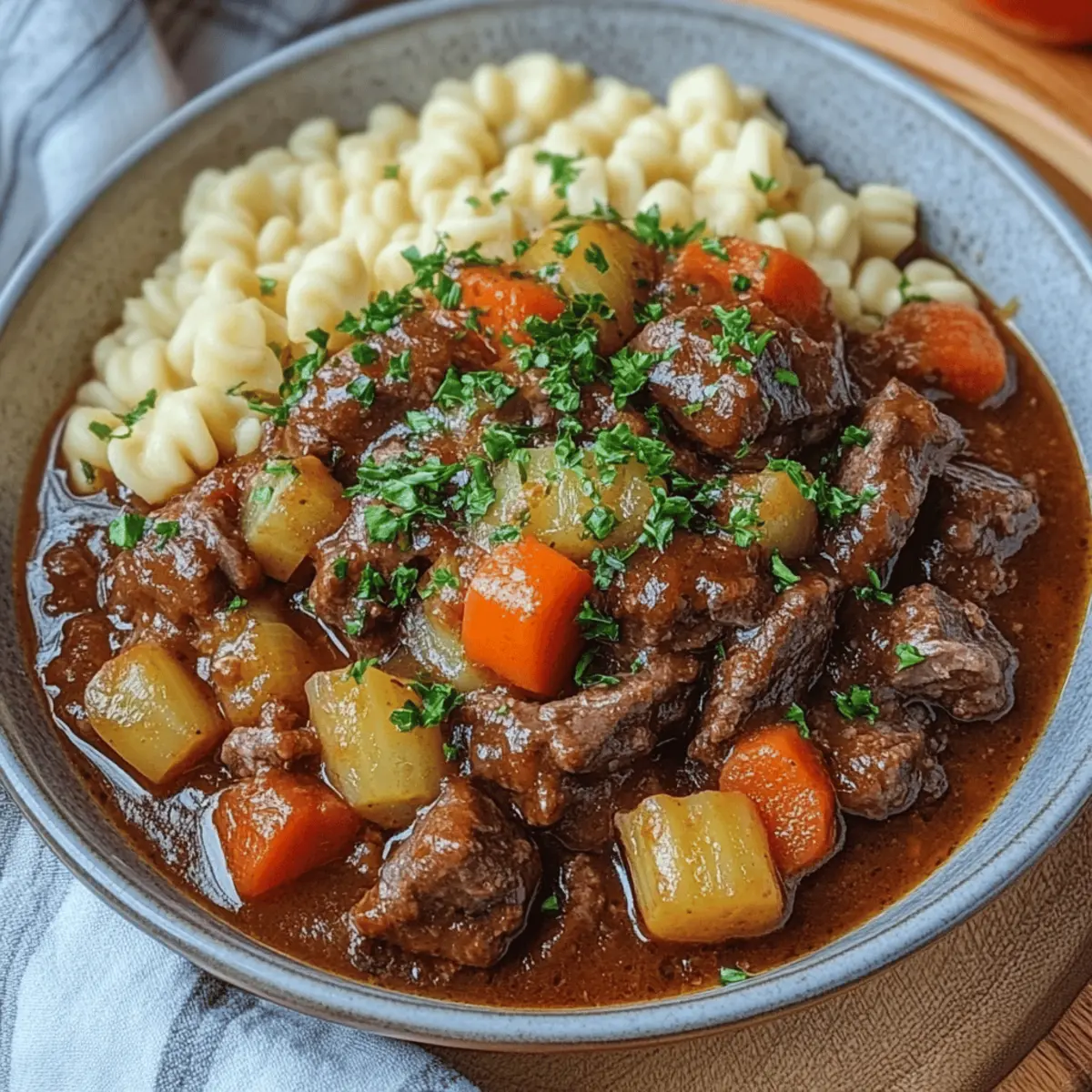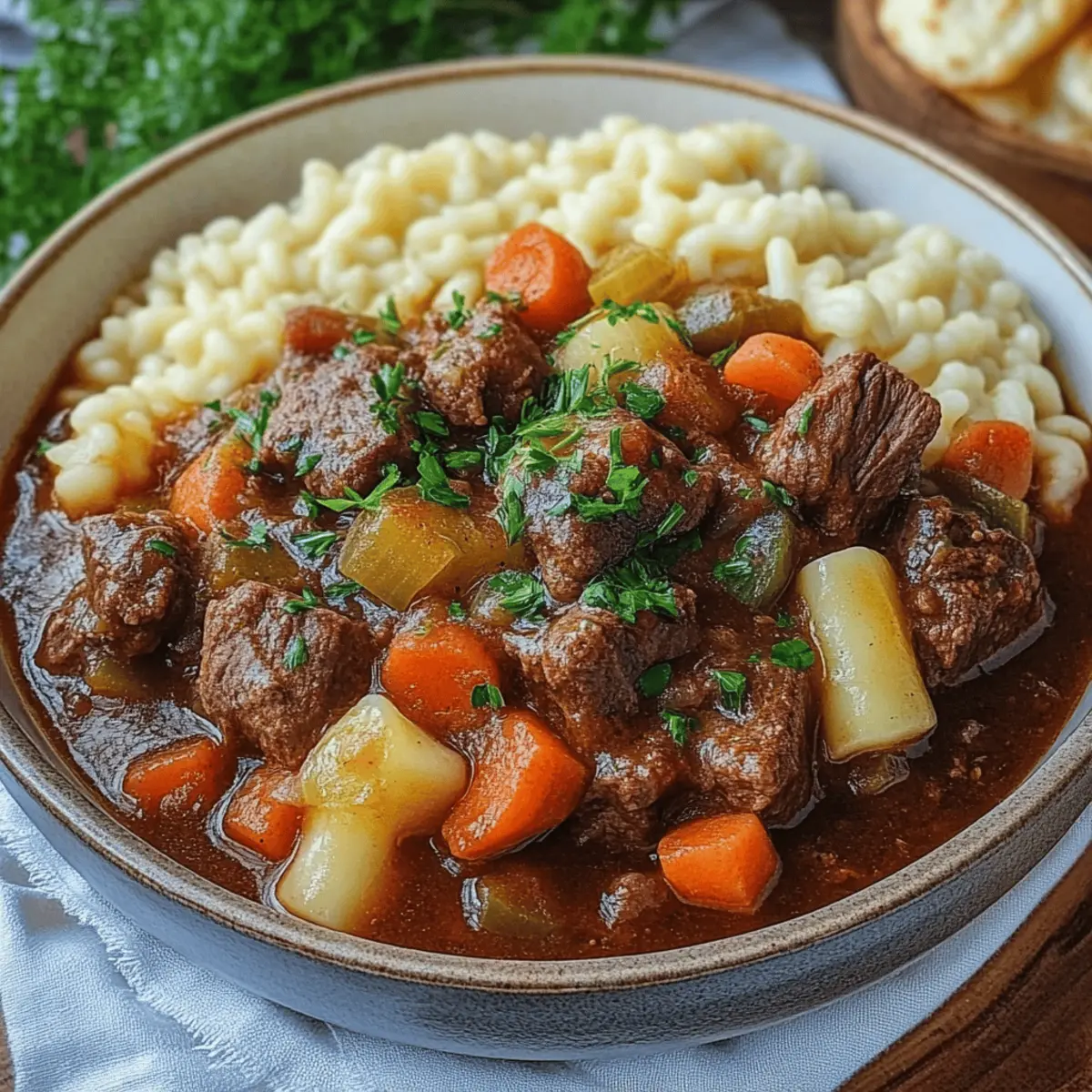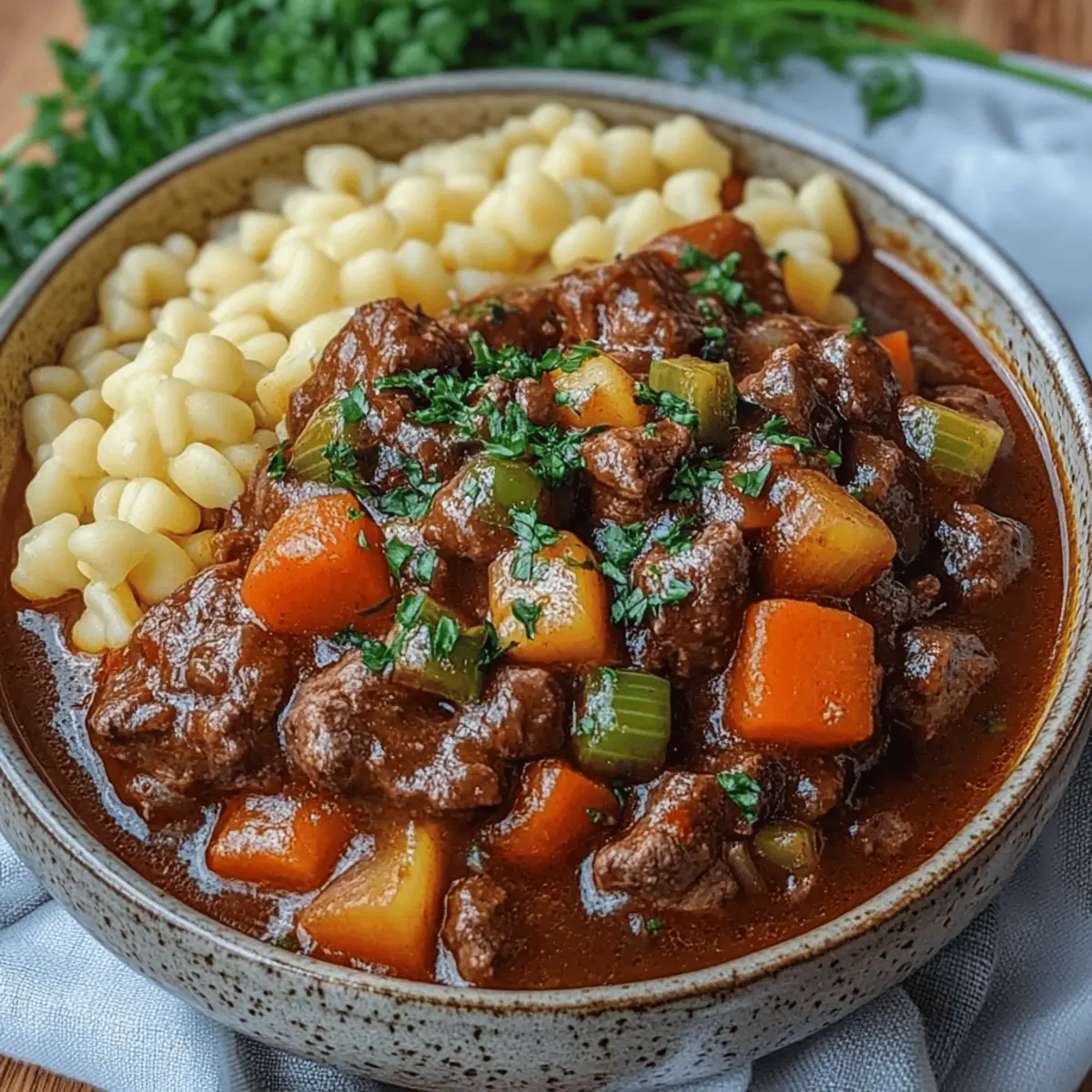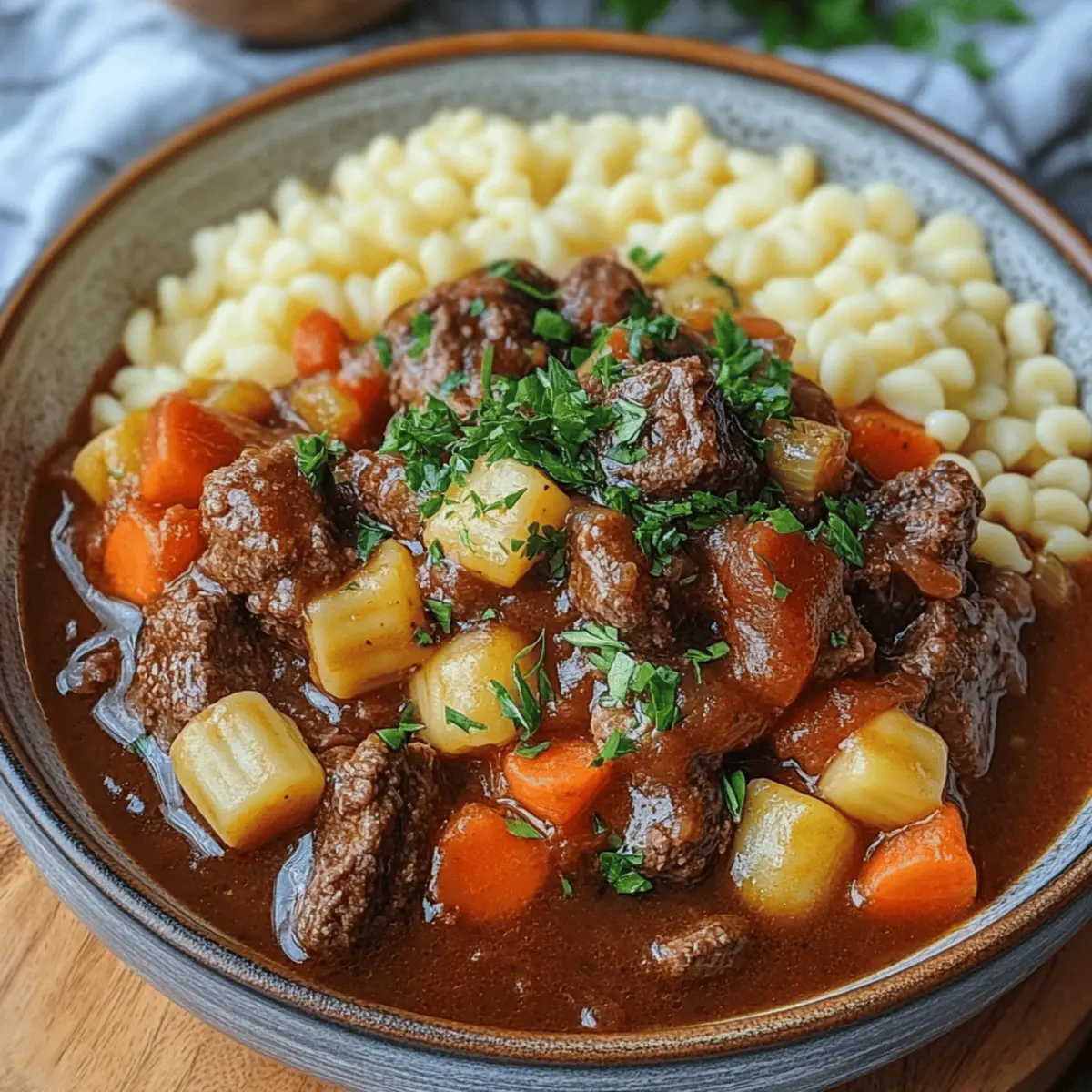The aroma of simmering beef on a chilly evening can instantly transport you to the heart of a German kitchen, where warmth, comfort, and tradition reign supreme. One of my all-time favorite dishes to whip up is German Goulash, a hearty stew that perfectly marries tender beef, caramelized onions, and a medley of flavorful spices like paprika and caraway. This recipe is not only easy to prepare, but it also promises to be a crowd-pleaser, making it ideal for cozy weeknight dinners or festive gatherings. With its rich depth and satisfying textures, you’ll find this dish drawing everyone to the table, eager to share in the delightful experience. Are you ready to uncover the secret to a truly authentic German Goulash?

Why Is German Goulash So Beloved?
Comforting and hearty, German Goulash warms the soul, making it a go-to dish for gathering around the table with loved ones. Versatile at its core, this recipe allows for can’t-miss variations, such as adding your favorite vegetables. Flavorful spices like paprika and caraway create a rich taste that keeps family members coming back for seconds. Plus, easy preparation means you don’t have to be a professional chef to master it! You can even save time with a few handy tips from our expert advice section. Dive into a bowl of this traditional stew, and you'll quickly see why it's a cherished favorite in homes everywhere!
German Goulash Ingredients
Elevate your cooking with these essential components!
For the Stew
- Beef Chuck – The star of the show; it adds the ideal richness and hearty texture. Can be substituted with pork shoulder for a unique flavor twist.
- Onions – Vital for a flavorful base; stick to yellow or white onions for the best results.
- Red Bell Peppers – Brings a pop of sweetness and color; green bell peppers can replace them for a slightly different taste.
- Yellow Bell Peppers – Offers an additional layer of sweetness and texture.
- Garlic – Infuses the dish with aromatic flavor; fresh is best, while dried can change the profile.
- Sweet Paprika – A key to the dish’s sweet undertone and color; consider smoked paprika for a lovely smoky flavor.
- Smoked Paprika – Enhances depth and flavor; optional but highly recommended for added complexity.
- Caraway Seeds – Lends an earthy note that’s essential; can be swapped with fennel seeds for a different zest.
- Marjoram – Provides a deep herbal flavor that’s pivotal in traditional recipes; oregano is a suitable substitute if needed.
- Cayenne Pepper (optional) – Adds a kick of heat; simply leave it out for a milder stew.
For the Broth
- Tomato Paste – Boosts the stew's umami richness; canned tomatoes can also be a fine alternative.
- Beef Broth – Serves as the savory base; vegetable broth can lighten up the dish if preferred.
- Red Wine (optional) – Adds a beautiful complexity; use beef broth or grape juice for a non-alcoholic version.
- Red Wine Vinegar – Balances the flavors with acidity; lemon juice also works well in a pinch.
For Thickening and Seasoning
- All-Purpose Flour – Ideal for thickening the stew; cornstarch serves as a gluten-free option.
- Olive Oil – For sautéing the ingredients, ensuring a lovely flavor infusion; any neutral oil will do.
- Salt and Black Pepper – Essential for seasoning; adjust according to your taste preference.
- Bay Leaf – Adds a lovely aromatic touch; don’t forget to remove it before serving.
For Garnish
- Fresh Parsley – A sprinkle of freshness that brightens the dish; essential for presentation.
- Sour Cream (optional) – Provides a creamy contrast when serving, with Greek yogurt as a healthier substitute.
Step‑by‑Step Instructions for German Goulash
Step 1: Prepare the Beef
Start by patting the beef chuck cubes dry with paper towels, then season them generously with salt and black pepper. This step is crucial for enhancing the flavor of your German Goulash. Set the seasoned beef aside while you heat your olive oil in a large pot over medium-high heat. Watch for the oil to shimmer, indicating it's ready for cooking.
Step 2: Brown the Beef
Add the beef cubes to the hot pot in a single layer, avoiding overcrowding. Sear the beef for about 3-4 minutes on each side until they develop a rich brown crust. This browning process builds flavor. Once browned, remove the beef from the pot and set it aside on a plate while you prepare the next ingredients.
Step 3: Sauté the Onions
In the same pot, add a bit more olive oil if needed, and toss in the chopped onions. Sauté the onions over medium heat for about 5-7 minutes, stirring occasionally, until they soften and become translucent. Their sweetness will start to emerge, creating a flavorful base for your German Goulash.
Step 4: Add Peppers and Garlic
Next, mix in the diced red and yellow bell peppers along with the minced garlic. Continue to sauté for another 5-7 minutes, until the peppers soften and the garlic becomes fragrant. This colorful mixture brings both sweetness and depth to your hearty stew, enhancing the traditional flavors of the German Goulash.
Step 5: Stir in Spices
Now, sprinkle in the sweet paprika, smoked paprika, caraway seeds, and marjoram. Stir the mixture well and cook for about 1-2 minutes until the spices become aromatic, coating the vegetables. This step infuses the German Goulash with its signature flavors, setting the stage for a rich and satisfying stew.
Step 6: Incorporate Tomato Paste
Add the tomato paste to the pot, stirring it into the vegetable mixture for an additional minute. This will help deepen the stew's richness and provide a nice umami kick. Make sure to cook off some of the raw tomato flavor, enhancing the overall taste of your German Goulash.
Step 7: Add Beef Broth and Wine
Pour in the beef broth and optional red wine, using a wooden spoon to scrape up any browned bits stuck to the bottom of the pot. This imparts even more flavor to your dish. Bring the mixture to a gentle simmer, allowing the rapid bubbling to indicate it's time to add back the beef.
Step 8: Simmer and Cook
Return the browned beef to the pot and throw in the bay leaf. Lower the heat to a gentle simmer, covering the pot. Let it cook for 2-3 hours, stirring occasionally, until the beef is tender and can easily be shredded with a fork. The long cook time ensures the flavors meld beautifully in your German Goulash.
Step 9: Thicken the Stew
To thicken the stew, prepare a flour slurry by mixing all-purpose flour with a small amount of water in a bowl. Stir the flour slurry into your simmering goulash and cook for another 10-15 minutes. This will create a luscious, thick broth that clings to the tender beef and veggies.
Step 10: Final Touches
Once thickened, remove the bay leaf from the pot and stir in the optional red wine vinegar to brighten the flavors. Taste and adjust seasoning with more salt and pepper if necessary. This final step ensures your German Goulash is perfectly balanced before serving.
Step 11: Serve and Garnish
Ladle the rich German Goulash into bowls, garnishing each serving with a sprinkle of fresh parsley for a burst of color. If desired, add a dollop of sour cream or Greek yogurt for creaminess that complements the hearty stew. Enjoy this comforting delight warm with crusty bread or spätzle!

German Goulash Variations & Substitutions
Feel free to mix things up with these simple and fun twists to make your German Goulash even more delightful!
-
Vegetable Boost: Add diced carrots or parsnips to enhance sweetness and nutrition; they’ll bring a comforting crunch to each bite.
-
Plant-Based Option: Substitute beef with a plant-based meat alternative for a vegetarian-friendly version; you won’t miss the meat!
-
Smoky Flavor: Use smoked paprika in place of sweet paprika for a deep, smoky twist; it adds a robust layer to the stew.
-
Zesty Kick: Incorporate chopped jalapeños or a dash of hot sauce for a spicy kick; this will awaken your taste buds and bring boldness to every spoonful.
-
Creamy Touch: Swap sour cream with Greek yogurt to provide a healthy creaminess when serving; it’s a great way to keep it light while delicious.
-
Broth Variation: Experiment with chicken broth instead of beef broth for a lighter broth and different flavor profile; it changes the complexion but keeps the warmth.
-
Herb Swap: Replace marjoram with thyme or Italian seasoning for a different herbal note; it will give your stew a fresh, fragrant twist.
-
Grain or Pasta Alternative: Serve with quinoa or pasta instead of traditional spätzle for a unique texture and flavor experience; they’re full of heartiness just like the goulash!
Make Ahead Options
German Goulash is an excellent choice for meal prep enthusiasts! You can chop the vegetables (onions, bell peppers, and garlic) and season the beef up to 24 hours in advance, storing them in the refrigerator to maintain freshness. Additionally, you can prepare the entire stew ahead of time and refrigerate it for up to 3 days. When you're ready to serve, simply reheat it on the stovetop over low heat, adding a splash of beef broth if needed to achieve the desired consistency. The flavors of your German Goulash will deepen as it sits, making it just as delicious, if not better, when prepared ahead. Enjoy this hearty, comforting dish with minimal effort on busy weeknights!
Expert Tips for German Goulash
- Brown the Beef: Sear the beef cubes until golden brown to develop deep flavors; don't overcrowd the pot, as this traps steam and prevents browning.
- Check Liquid Levels: Keep an eye on the stew while it simmers; add extra beef broth if it looks too thick or dry to ensure a comforting consistency.
- Adjust Seasoning: Taste before serving; a sprinkle of extra salt or a dash of red wine vinegar can elevate the flavor balance of your German Goulash.
- Thicker Stew: For a heartier texture, let the goulash simmer a little longer after adding the flour slurry; this gives flavors a chance to meld beautifully.
- Time to Rest: Allow the goulash to rest for at least 10 minutes before serving; this helps the flavors enhance and settle together, making each bite even better.
How to Store and Freeze German Goulash
Fridge: Store leftover German Goulash in an airtight container for up to 3 days. The flavors will deepen, creating a culinary treasure for the next meal!
Freezer: Goulash freezes beautifully for up to 3 months. Let it cool completely, then transfer it to freezer-safe bags, removing as much air as possible to prevent freezer burn.
Reheating: To reheat, thaw in the fridge overnight and warm gently on the stove over low heat, adding a splash of beef broth if needed to restore moisture.
Serving Tips: When reheating, serve hot and consider garnishing with fresh parsley or a dollop of sour cream to refresh the dish before enjoying this comforting delight!
What to Serve with German Goulash
Creating a memorable meal doesn’t stop at the main dish; it’s about pairing flavors and textures that elevate your dining experience.
-
Creamy Mashed Potatoes: The buttery, smooth texture of mashed potatoes creates a perfect canvas for the rich goulash, soaking up all its flavors.
-
Crusty Bread: A warm, crispy loaf is ideal for dipping and soaking up the flavorful broth, adding a satisfying crunch to each bite.
-
Crisp Green Salad: A fresh salad with tangy vinaigrette provides a bright contrast that balances the hearty nature of German Goulash, refreshing your palate.
-
Spätzle: This traditional German pasta dish offers a delightful chewiness, making it an excellent side that complements the luxurious goulash sauce.
-
Roasted Vegetables: Carrots, Brussels sprouts, and potatoes, seasoned and roasted, add a delightful sweetness that contrasts beautifully with the savory stew.
-
German Beer: A chilled lager or wheat beer enhances the meal’s essence and elevates the traditional flavors of the goulash, creating a well-rounded dining experience.
-
Applesauce: A side of homemade applesauce introduces a touch of sweetness, which perfectly balances the spiciness of the goulash and ties the meal together.
Each of these pairings not only complements the German Goulash beautifully but also adds depth and excitement to your dinner. Enjoy crafting the perfect meal for your loved ones!

German Goulash Recipe FAQs
How do I choose the right beef for German Goulash?
Absolutely! For the best results, look for beef chuck. It’s well-marbled, which means it has enough fat to melt during the long cooking process, ensuring tender, juicy pieces of meat. Avoid lean cuts like sirloin, as they can become tough.
How should I store leftover German Goulash?
Very simple! Once the goulash has cooled, place it in an airtight container and store it in the refrigerator. It will keep well for up to 3 days. If you want to keep it longer, consider freezing!
Can I freeze German Goulash? How?
Absolutely! To freeze your goulash, allow it to cool completely. Transfer it to freezer-safe bags, ensuring to squeeze out as much air as possible to prevent freezer burn. It can last up to 3 months in the freezer. When ready to enjoy again, simply thaw it overnight in the fridge and reheat gently on the stove, adding a bit of beef broth if needed to maintain moisture.
What if my goulash turns out too thick?
Oh, that happens sometimes! If your goulash is thicker than you’d like, just stir in a little additional beef broth or water as it simmers. You can do this gradually until it reaches your desired consistency. Taste it after adjusting and season if needed!
Is there a vegetarian option for German Goulash?
The more the merrier! You can absolutely create a vegetarian version by swapping the beef for a plant-based meat substitute. Use vegetable broth instead of beef broth and add more vegetables like carrots and potatoes to maintain the hearty feel of the dish.
Can dogs eat German Goulash?
I recommend caution! While some ingredients like beef and carrots can be safe for dogs, others like onions and garlic are toxic to them. If you want to share a taste with your pup, prepare a plain version without these harmful ingredients or consult your vet first!

Hearty German Goulash: A Comforting Delight for All
Ingredients
Equipment
Method
- Pat the beef chuck cubes dry with paper towels, season with salt and black pepper, and set aside.
- In a large pot, heat olive oil over medium-high heat, then add the beef cubes in a single layer and sear for 3-4 minutes on each side.
- Remove the browned beef and set it aside. In the same pot, sauté chopped onions for 5-7 minutes until they soften.
- Mix in diced red and yellow bell peppers and minced garlic, continuing to sauté for another 5-7 minutes.
- Sprinkle in the sweet paprika, smoked paprika, caraway seeds, and marjoram, cooking for 1-2 minutes until aromatic.
- Stir in tomato paste for an additional minute, then add beef broth and optional red wine, scraping up browned bits from the pot.
- Return the beef to the pot, add bay leaf, lower the heat to simmer, cover, and cook for 2-3 hours.
- Prepare a flour slurry and stir it into the goulash, cooking for another 10-15 minutes to thicken.
- Remove bay leaf and stir in red wine vinegar, adjusting seasoning with salt and pepper as needed.
- Ladle goulash into bowls, garnish with parsley, and serve warm with crusty bread or spätzle.





Leave a Reply